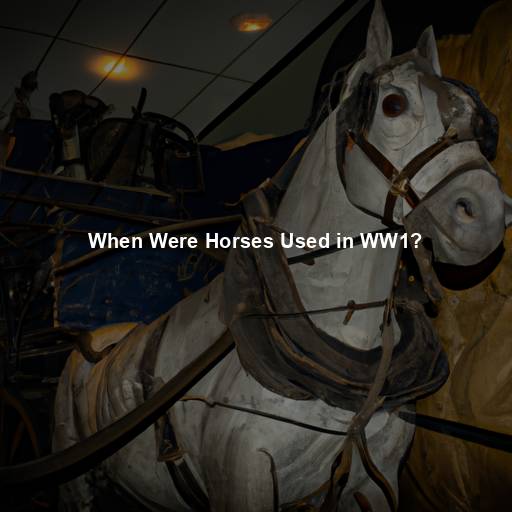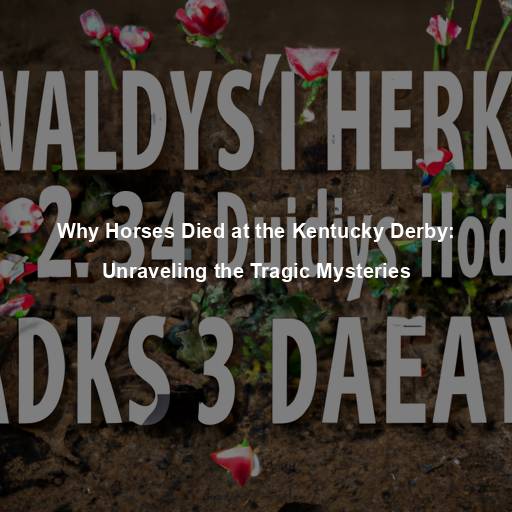When Were Horses Used in WW1?
Last Updated on November 17, 2023 by Evan
Contents
- 1 The Role of Horses in World War I
- 1.1 Horses as a Means of Transportation
- 1.2 Cavalry Charges and Combat
- 1.3 The Changing Nature of Warfare
- 1.4 Communication and Support Roles
- 1.5 Harsh Conditions and Challenges
- 1.6 The Impact of Technology
- 1.7 Legacy and Remembrance
- 1.8 Companionship and Comfort
- 1.9 Shared Hardships and Camaraderie
- 1.10 The Loss and Grief
- 2 The Role of Horses in Modern Warfare
- 3 The Ethical Considerations
- 4 Commemorating the Equine Heroes
- 5 FAQs – When Were Horses Used in WW1
- 5.1 Q: Were horses used during World War 1?
- 5.2 Q: What was the purpose of using horses in WW1?
- 5.3 Q: Which countries employed horses in WW1?
- 5.4 Q: Did all soldiers use horses in WW1?
- 5.5 Q: How were the horses transported to the battlefield?
- 5.6 Q: How did horses fare in the harsh conditions of WW1?
- 5.7 Q: Were any particular breeds of horses favored for military use in WW1?
- 5.8 Q: How many horses were estimated to have served in WW1?
- 5.9 Q: Did the use of horses in WW1 continue throughout the entire war?
- 5.10 Q: What happened to the horses after WW1 ended?
The Role of Horses in World War I
World War I, also known as the Great War, was a conflict that engulfed the world between 1914 and 1918. It was a time of unprecedented advancements in technology, with new weapons and machinery revolutionizing the way wars were fought. However, amidst all the modern warfare, one might wonder: when were horses used in WW1?
Horses as a Means of Transportation
Horses played a significant role in World War I, primarily as a means of transportation. In the early stages of the war, before the widespread use of motorized vehicles, horses were essential for moving troops, supplies, and artillery across the treacherous terrains of the battlefields. They provided mobility and agility that machines of the time couldn’t match.
Cavalry Charges and Combat
Horses were not only used for transportation but also in combat. Cavalry units, armed soldiers mounted on horseback, were employed by various armies during the war. These cavalry charges aimed to exploit weaknesses in the enemy’s lines and strike fear into the hearts of the opposition. However, the role of cavalry in World War I was controversial and marked a transition in the way wars were fought.
The Changing Nature of Warfare
In the ever-evolving landscape of warfare, the arrival of cutting-edge armaments brought forth a maelstrom of perplexity for traditional cavalry strategies. With the emergence of formidable machinery, from the thunderous rattle of machine guns to the earth-shattering might of artillery, the once-majestic and agile cavalry charges found themselves ensnarled in a tangle of chaos and confusion. The immutable fortifications of trench warfare stood defiantly against the valiant thundering hooves, leaving the once-vital cavalry to grapple with their dwindling potency on the battlefield, as the relentless tide of war pressed onward.
Communication and Support Roles
In the vast panorama of World War I, where change clung to the air like the scent of fear, one luminary remained steadfast: the noble horse. Amidst the withering fire of modern warfare, their thunderous hooves echoed with a timeless fervor. These steadfast equine companions cemented their place in history, galloping through the crucible of battle to deliver messages that bridged the chasms of chaos, becoming the guardians of communication. As the harbingers of life-saving essentials, they bore the weight of hope on their sturdy backs, a symphony of purpose amidst the cacophony of war.
Harsh Conditions and Challenges
Amidst the turmoil and tumult of war, the noble horses grappled with an array of hardships that tested their mettle. From the deafening clamor and inky smoke of the battleground to the relentless barrage of enemy fire, these gallant creatures were forced to confront their fears head-on. As if the perils of the battlefield were not enough, the horses trudged through treacherous terrains, battling the mire of muddy trenches while braving the whims of an unpredictable climate. Yet, in the face of such adversities, their loyalty remained unshakeable, and their unwavering commitment to their human companions shone brightly.
The Impact of Technology
As the gripping narrative of World War I unfolded, the relentless march of progress witnessed a seismic shift on the battlefield. Intractable horses, once the stalwarts of warfare, yielded their dominance to the inexorable advance of mechanized might. The advent of motorized vehicles, epitomized by the audacious trucks and formidable tanks, endowed military forces with hitherto unfathomable mobility, firepower, and protection. As this tectonic upheaval unfolded, horses, once paramount in combat, found a new niche in transportation and logistical prowess, resiliently galloping alongside the relentless march of modernity.
Legacy and Remembrance
The remarkable contribution of horses during the tumultuous era of World War I stands as a powerful testament to their unwavering allegiance and dedication. These noble creatures played an integral role in the war machinery, braving inconceivable challenges side by side with their human comrades. Over time, numerous memorials and monuments have risen to immortalize their profound sacrifice on the battlefield, paying homage to the indelible bond shared between humans and animals during times of strife. Their enduring legacy serves as a poignant reminder of the immense contributions made by animals in the crucible of conflict.
Companionship and Comfort
Beyond their utilitarian roles, horses played a significant role in providing emotional support to soldiers during World War I. The bond between soldiers and their horses was often profound, offering companionship and a sense of comfort amidst the chaos of war. The presence of a loyal and trusted animal companion provided solace and a reminder of home.
The camaraderie between soldiers and horses during times of war cannot be understated. In the face of adversities like inclement weather, looming dangers, and the chilling reality of witnessing brutal combat, these resilient beings found solace in each other’s presence. It transcended the boundaries of mere human-animal relationship, blossoming into an unbreakable bond founded on trust, empathy, and unwavering support. The horses evolved from being mere companions to becoming irreplaceable confidants and cherished allies in their shared journey through the grueling hardships of warfare.
The Loss and Grief
The loss of a horse was a deeply emotional experience for soldiers. When a horse fell in battle, it was not just the loss of a valuable asset but also the loss of a cherished companion. Soldiers mourned the deaths of their horses, grieving for the lives lost and the bond severed. The emotional toll of these losses added to the already heavy burden carried by soldiers.
The Role of Horses in Modern Warfare
Transitioning to Modern Warfare
The era of World War I proved an epochal juncture in the intricate dance between horses and war. A mesmerizing tango of technology and shifting battlefronts nudged humanity towards a sudden and perplexing descent in equine reliance. As the machines roared to life, their imposing presence doused the battlefield with a combustible blend of swiftness, might, and a protective cocoon, eclipsing the humble steeds in this beguiling saga of armaments.
Horses in Contemporary Military Roles
In an era where warfare has evolved vastly, the use of horses may seem like a perplexing notion, yet these majestic creatures surprisingly bear a significant burden in modern military endeavors. With their nimble agility and adaptability, horses find solace in the resilient terrains and unyielding landscapes that defy conventional technology. In select regions plagued by scant infrastructure, they emerge as the sturdy backbone that conducts vital reconnaissance, patrols remote areas, and facilitates transportation operations. As an homage to the legacy of horsemanship, these specialized units traverse uncharted territories with an enigmatic blend of tradition and practicality, leaving us in awe of their enduring role.
The Symbolic Role of Horses
Horses continue to hold a symbolic significance in military ceremonies and traditions. They are often seen in parades, representing the historical connection between the military and these noble animals. The image of a mounted soldier evokes a sense of tradition, honor, and bravery, paying homage to the cavalry units of the past.
The Ethical Considerations
Animal Welfare and Protection
The use of horses in war raises ethical considerations regarding the treatment and well-being of these animals. The harsh conditions, injuries, and stress experienced by horses during wartime can be significant. It is essential for military organizations to prioritize the welfare and protection of these animals, ensuring proper care, veterinary support, and retirement plans for horses that have served in combat.
Evolving Perspectives
Over time, societal attitudes towards the use of animals in warfare have shifted. The recognition of animals as sentient beings capable of experiencing pain and suffering has led to increased scrutiny and calls for ethical treatment. As we continue to reflect on the role of horses in World War I, it is crucial to consider their well-being and the lessons learned from our historical use of animals in conflict.
Commemorating the Equine Heroes
Memorials and Monuments
Traveling across the globe, one cannot help but be struck by the myriad of memorials and monuments that stand tall, stoically etching the horses’ valiant contributions and heart-wrenching sacrifices during the tumultuous era of World War I. In reverential silence, these solemn structures weave an intricate tapestry of remembrance, beckoning us to contemplate the profound connection shared between mankind and these majestic creatures. Like guardian sentinels of the past, these poignant tributes stand as a testament to the unwavering bond that transcends time, reminding us of the indomitable spirit of our equine heroes.
Stories and Legends
Over the years, countless stories and legends have emerged, highlighting the bravery and heroism of both soldiers and their horses during World War I. These tales capture the resilience, loyalty, and unwavering spirit of these animals in the face of adversity. They serve as a reminder of the extraordinary bond that can be formed between humans and animals, even in the most challenging circumstances.
Supply and Logistics
During the tumultuous times of World War I, equine companions emerged as unsung heroes, shouldering the weighty responsibility of facilitating supply and logistics operations. These majestic creatures gallantly transported an assortment of vital provisions to the front lines, from sustenance for weary soldiers to crucial ammunition. Without their unwavering devotion and tireless efforts, the armies would have undoubtedly stumbled in their desperate pursuit to sustain their troops and uphold their operational prowess.
Versatility and Adaptability
Throughout the tumultuous era of World War I, the profound significance of horses became abundantly apparent, their intrinsic ability to gracefully conquer a myriad of treacherous terrains set them apart from their mechanical counterparts. These majestic creatures effortlessly maneuvered through the unforgiving landscapes of muddy trenches, unwaveringly surmounted steep hills, and gallantly ventured into the depths of dense forests. Their unparalleled adaptability and unwavering spirit bestowed upon them an unparalleled value on the battlefield, forever etching their hoofprints in the annals of history.
Medical Support
Horses also provided invaluable support in medical operations during the war. They were used to transport wounded soldiers from the front lines to field hospitals and aid stations. These brave animals carried injured soldiers on stretchers or pulled ambulances, often enduring dangerous conditions to ensure timely medical care for the wounded.
Psychological Impact
As soldiers stepped foot onto the battlefield, a curious and profound phenomenon unfolded before their eyes. The majestic and commanding presence of horses, both visually and audibly, sent ripples of perplexity and wonder throughout their ranks. It was as if an unseen force infused the very air with bursts of courage and unwavering resolve, igniting the spirits of the troops. These magnificent creatures, symbolizing not just physical might but also indomitable spirit, became beacons of inspiration, rallying soldiers to fight relentlessly for their cause.
The End of an Era
World War I marked the beginning of the end for cavalry units and the extensive use of horses in warfare. The increasing mechanization of armies and the introduction of tanks, trucks, and other motorized vehicles gradually replaced the need for horses on the battlefield. However, the contributions of these noble animals in World War I should never be forgotten.
Honoring the Equine Heroes
It is truly remarkable to witness the global effort that has been poured into commemorating the brave horses who selflessly served in the tumultuous World War I. From the corners of the earth, organizations and memorials have sprung up, dedicated solely to honoring these equine heroes. These powerful monuments not only stand as a testament to their sacrifices, but also serve as poignant reminders of the significant impact they had in shaping the very course of history. As we step foot into these hallowed grounds, we are enveloped with a sense of awe and reverence, inspiring moments of deep reflection and heartfelt gratitude for these unsung champions.
Lessons Learned
The haunting tales of horses on the battlefields of World War I continue to captivate us, offering profound insights for generations to come. These noble creatures, once considered the backbone of military might, found themselves caught in a perplexing and ever-changing landscape of warfare. Their presence sheds light on the dynamic nature of military strategies, urging us to adapt, innovate, and stay one step ahead. As we contemplate their sacrifice, we also recognize the imperative of safeguarding the welfare and rights of animals during times of conflict, fostering a culture rooted in ethical consideration and humane stewardship.
The Enduring Bond
The profound alliance forged amidst the tumultuous backdrop of World War I, between valiant soldiers and their gallant horses, epitomizes the extraordinary rapport that can blossom amid trying circumstances. It poignantly epitomizes the remarkable ability of both humans and animals to extend genuine empathy, unyielding compassion, and unwavering solidarity irrespective of their species. The enduring tale of this profound bond stands as an awe-inspiring homage to the unwavering fortitude and unbreakable unity inherent in the intricate tapestry of the human-animal connection. Its legacy echoes with a resounding testament to the indomitable spirit and boundless potency that emerges when hearts intertwine across boundaries both known and unfathomable.
FAQs – When Were Horses Used in WW1
Q: Were horses used during World War 1?
During the tumultuous era of World War 1, the indomitable spirit of the horse reverberated across battlefields, weaving themselves into the intricate tapestry of warfare. These majestic creatures emerged as steadfast companions and allies, shouldering the arduous burden of transportation, charging fearlessly into the chaos of cavalry assaults, and tirelessly facilitating the supply logistics for the myriad armies embroiled in this cataclysmic conflict. Their presence on the frontlines added a perplexing layer to the already bewildering and volatile nature of warfare, forever etching their hoofprints in the annals of history.
Q: What was the purpose of using horses in WW1?
A: Horses were mainly used as a means of transport in World War 1. They were utilized to pull artillery, supplies, and equipment to and from the front lines. Additionally, horses were crucial for cavalry units, allowing swift movement and charges on the battlefield.
Q: Which countries employed horses in WW1?
A: Numerous countries involved in World War 1 employed horses. Some of the prominent nations that used horses in various capacities include Britain, Germany, France, Russia, Austria-Hungary, and the United States, among others.
Q: Did all soldiers use horses in WW1?
A: No, not all soldiers used horses in World War 1. Horses were primarily utilized by cavalry units, artillery, and logistical support units. Infantry soldiers generally did not rely on horses for transportation, as they mostly marched on foot during the war.
Q: How were the horses transported to the battlefield?
A: Horses were transported to the battlefield in a variety of ways. Many were procured locally from the regions near the front lines. Others were transported by rail or by ship to the areas where they were needed. Once in the war zone, horses would often march alongside the troops or be used for pulling wagons and artillery pieces.
Q: How did horses fare in the harsh conditions of WW1?
A: Horses endured extremely challenging conditions during World War 1. The war brought forth treacherous terrains, including muddy trenches, barbed wire, and shell-cratered grounds. These conditions often resulted in horse casualties due to injuries, exhaustion, or exposure to the elements.
Q: Were any particular breeds of horses favored for military use in WW1?
In the tumultuous era of World War 1, the brimming chaos demanded the indispensable aid of our noble equine companions. Amidst the quagmire, the incessant clamor for diligent horsepower birthed a vibrant tapestry of equestrian diversity. From the mighty Percheron and sturdy Shire horses, steadfastly maneuvering under the weight of artillery and unwieldy equipment, to the illustrious Thoroughbred and graceful Arabian, swift and poised for the relentless cavalry charges. The orchestration of this extraordinary menagerie of breeds unravelled an enigmatic ballet of function and form, showcasing the unyielding spirit of these majestic creatures on the battlefield.
Q: How many horses were estimated to have served in WW1?
A: It is estimated that approximately eight million horses were used during World War 1. These horses were employed across multiple theaters of war and had a significant impact on the success of various military operations.
Q: Did the use of horses in WW1 continue throughout the entire war?
The indomitable spirit of the horse galloped valiantly through the trenches of World War 1, a testament to the bond between man and beast. Yet, as the gears of innovation turned and the cacophony of modernity grew louder, the cavalry’s hoofprints faded into the dust of antiquity. The relentless march of mechanized marvels—towering tanks and thunderous trucks—lumbered onto the battlefield, eclipsing the once-unwavering reliance on our equine companions.
Q: What happened to the horses after WW1 ended?
In the turbulent aftermath of World War 1, a perplexing reality emerged for our loyal equine companions. Countless horses, once indispensable on the battlefield, found themselves thrust into uncertainty. While some were fortunate enough to secure a new lease on life through sale or auction, others tragically met their end, succumbing to their injuries or deemed obsolete. Yet the enigma deepened as these noble beasts were abandoned on foreign soil, while a select few were repatriated or bestowed upon local farmers and communities. The poignant tale of these forgotten heroes resonates with the complex tapestry of post-war turmoil and transition.







